
4.9★ on G2 reviews

4.7★ on Capterra reviews
Explore fresh, expert perspectives on customer engagement and innovation
Stay at the forefront of customer engagement, contact centre innovation, and AI-powered communication.
discover the latest
articles and insights

Is Your Outbound Sales Team Truly Data-Driven?
Staying ahead of the competition is no longer just about having a talented team and a great product. Outbound sales teams can’t rely on instinct alone. Today’s successful sales operations are built on a foundation of data-driven decisions, cutting-edge technology, and continuous improvement.
But what does it really mean to be “data-driven” in outbound sales?
MaxContact’s 2024 KPI Benchmarking Report provides valuable context for the state of outbound sales. With an average of 65.55 daily calls per agent and a mean success rate of 6.74%, it’s clear that volume alone doesn’t guarantee success. The question is: how can you use this type of data to drive meaningful improvements in your team’s performance?
Embrace Advanced Dialling Technology
One of the most impactful ways to make your outbound sales team more data-driven is by implementing advanced dialling technology. Predictive dialling solutions use real-time data to optimise call pacing, ensuring agents spend more time talking to prospects and less time waiting between calls.
Our benchmarking report reveals that top-performing teams handle between 31 and 60 calls per agent per day. By leveraging predictive dialling, you can help your team reach or exceed this benchmark efficiently. MaxContact’s ‘undroppable’ feature and ‘degrade to progressive’ setting use data to balance aggressive outreach with compliance requirements, addressing the industry-wide challenge of maintaining high contact rates while avoiding regulatory penalties.
Implement Intelligent Lead Prioritisation
Not all leads are created equal, and a truly data-driven team recognises this fact. The benchmark report shows that the average first-call close rate is 27.81%, with nearly 30% of teams achieving 20 to 29%. To improve these figures, move beyond simple “first in, first out” approaches to lead management.
Consider implementing custom data fetching and prioritisation tools that allow you to rank leads based on criteria such as potential deal size, recent interactions, or historical conversion rates. This approach ensures your team is always focusing on the most promising opportunities, significantly increasing the chances of success.
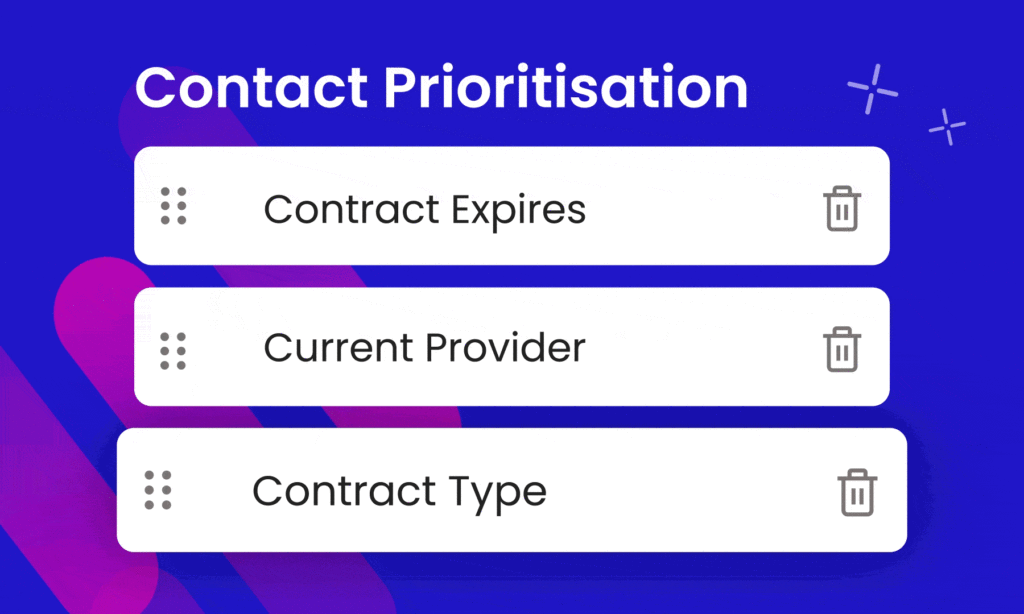
Match the Right Agent to the Right Lead
Data can play a crucial role in ensuring each lead is handled by the most suitable agent. MaxContact’s benchmark report indicates that the mean average revenue per call is £197.60, but nearly a quarter of teams generate much less, averaging £30 to £59 per call. This disparity suggests that proper lead-agent matching could significantly impact revenue.
Implementing a dialler with outbound skill-based routing that automatically matches leads with agents based on factors such as product knowledge, industry experience, or past performance with similar leads. This data-driven approach to call routing can dramatically improve conversion rates and average revenue per call.
Leverage Real-Time Analytics for Agile Decision Making
The world of sales is volatile, and simply waiting for end-of-day or weekly reports in this market just isn’t going to cut it. Empower your team leaders with real-time analytics dashboards that allow them to monitor performance as it happens and make immediate adjustments.
Real-time dashboards enable managers to spot trends or issues as they emerge, allowing for rapid response. This could mean reallocating resources, adjusting scripts, or providing on-the-spot coaching to underperforming agents. According to a study by McKinsey, companies that use customer analytics comprehensively report exceed their competition in terms of profit almost twice as often as companies that do not.
Utilise AI-Powered Speech Analytics for Deeper Insights
To truly understand what’s happening in your sales conversations, consider implementing AI-powered speech analytics. Tools like Spokn AI can analyse 100% of your customer interactions, providing insights that would be impossible to gather manually.
Speech analytics has emerged as a game-changing tool for outbound sales teams, transforming customer conversations into a goldmine of actionable insights. This technology analyses audio from customer calls, identifying key topics and detecting customer sentiment.
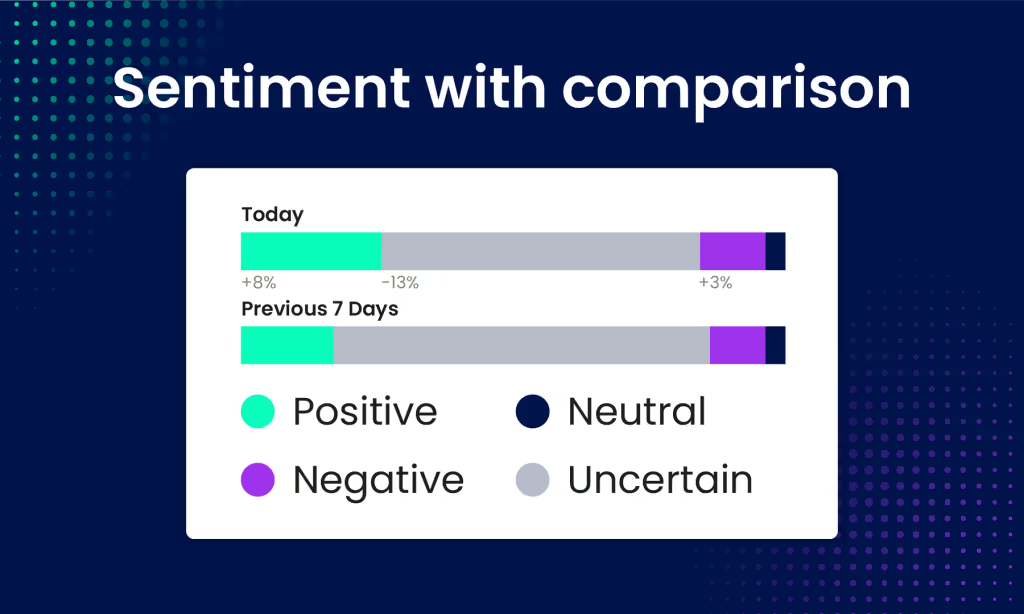
Key benefits for outbound sales teams include:
- Enhanced Agent Training: Identify successful techniques and areas for improvement, allowing for targeted training programmes.
- Customer Sentiment Analysis: Detect changes in tone and emotion, helping agents adapt their approach in real-time.
- Quality Assurance at Scale: Analyse every call, ensuring comprehensive QA and quick identification of compliance issues.
- Identifying Sales Opportunities: Recognise patterns in successful calls to refine sales scripts and strategies.
- Competitor Intelligence: Flag mentions of competitors, providing valuable market insights.
- Trend Identification: Quickly spot emerging trends in customer behaviour or common objections.
By implementing speech analytics, outbound sales teams can gain data-driven insights that lead to more effective strategies, improved customer experiences, and better business outcomes. Use these insights to identify common objections, spot successful sales techniques, and provide targeted coaching to your team. A recent study by Forrester found that companies using AI-driven speech analytics saw a 10% increase in customer satisfaction scores and a 15% improvement in first-call resolution rates.
With speech analytics, you’re not just collecting more data – you’re gaining the ability to understand and act on the nuances of every customer interaction, transforming your outbound sales operation into a truly data-driven powerhouse.
Foster a Culture of Continuous, Data-Driven Improvement
Creating a data-driven outbound sales team goes beyond implementing new technologies—it’s about fostering a culture where data informs every decision. This shift requires a multi-faceted approach that engages every level of your organisation.
Set clear, data-backed goals using industry benchmarks and your historical data. Aim to exceed average performance metrics, such as the 6.74% success per call rate revealed in our benchmark report. Make these goals visible and track progress regularly, ensuring everyone understands how their efforts contribute to team objectives.
Invest in data literacy across your team. Provide training programmes that help staff understand and interpret key metrics. This empowers them to make data-driven decisions in their daily work, whether it’s analysing call data or interpreting conversion rates.
Implement regular data review meetings. Use this time to discuss trends, celebrate successes, and collaboratively identify areas for improvement. Encourage team members to share insights they’ve gained from their own data analysis, fostering a culture of shared learning.
Use data to personalise coaching and development plans for each agent. This tailored approach not only leads to more effective improvements but also demonstrates the practical value of data in personal growth and career progression.
The Path to Data-Driven Success
Transforming your outbound sales team into a data-driven powerhouse is a journey, not a destination. It requires a commitment to continuous improvement, investment in the right tools, and a willingness to let data challenge assumptions and drive decision-making.
Implementing these strategies and leveraging advanced solutions can unlock the full potential of your outbound sales team. You’ll be able to optimise processes in real-time, provide more personalised experiences to prospects, and continuously refine your strategies based on concrete insights.
Remember, the goal isn’t just to collect data – it’s to use that data to drive meaningful improvements in performance, efficiency, and ultimately, sales success. With the right approach and tools, you can not only meet but exceed the benchmarks set by top-performing teams in the industry.
Are you ready to take your outbound sales to the next level? Get in touch with the team today and explore how MaxContact can help your sales become truly data-driven.

Insights for your IT strategy
In a poll of IT leaders carried out for MaxContact in August 2023, 99% of respondents said they were planning to invest in digital transformation over the next 12 months.
So it’s clear this is an area of focus, but what are their priorities, and – in a challenging economy – what will they spend limited IT budgets on? In addition, what barriers do they face as they look to drive digital transformation plans forward?
Our research revealed lots of interesting insight for IT leaders, and you can read the full report here.
In the rest of this article, we’ll summarise the key findings.
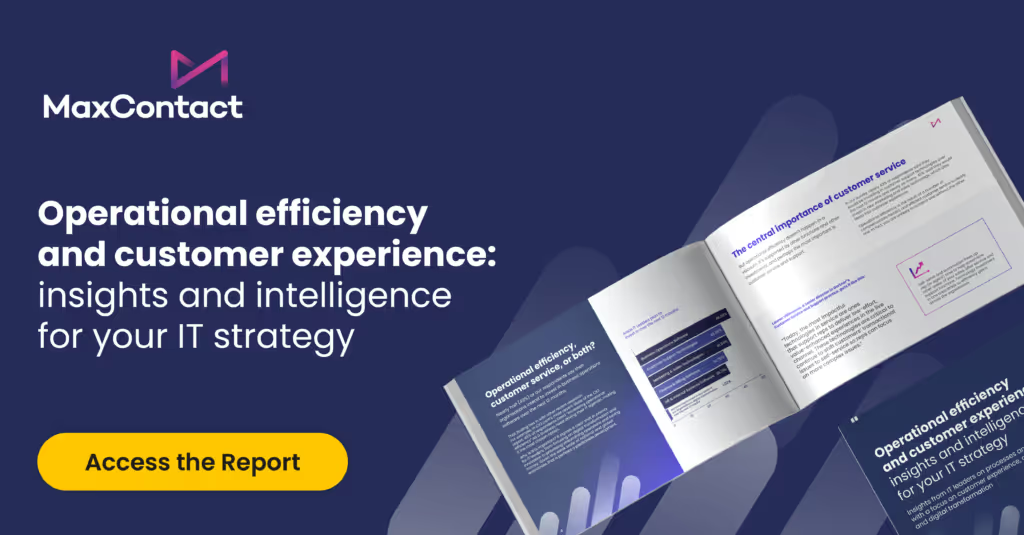
Chasing operational efficiency
Nearly half of our respondents (48.98%) said they plan to invest in business operations software over the next 12 months. That ties in with a general push towards operational efficiency as economic uncertainty persists. Organisations have subtly shifted their priorities away from more general innovation and towards a more targeted goal of streamlining operations, to reduce cost.
At 42.86%, customer support technologies were the next most popular choice, followed by digital marketing and sales tools. IT leaders understand that operational efficiency is the result of several connected factors, and streamlined customer support and sales are essential to an organisation’s smooth operation.
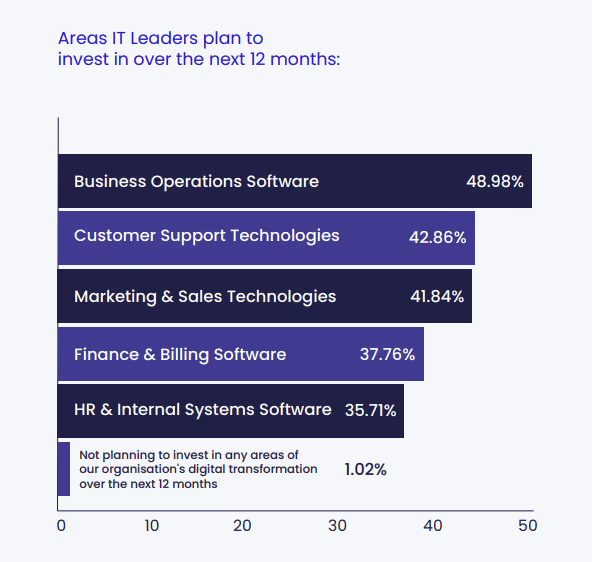
The path to digital transformation
What of digital transformation? Digital transformation is the integration of digital technology into every area of a business. The good news from our survey is that 50% of respondents said their organisations have largely transitioned to digital ways of working. A further 35% say they have a ‘digital-first’ philosophy.
That’s positive because it suggests that, in most cases, wider digital transformation efforts haven’t been entirely sacrificed to reduce costs. It’s up to IT leaders to convince CEOs and MDs that digital transformation, done properly, is one of the surest paths to cost efficiency. Digital-first businesses tend to be more agile, scalable and productive than less advanced competitors.
Despite that, our survey revealed that a significant minority of respondents (16%) have some way to go before they reach digital maturity. Some are still in the planning stage, and a few are yet to even consider their wider digital strategy. They may be OK right now, but a head-in-the-sand approach to technology is not sustainable in the long run.

Barriers to new IT adoption
Digital transformation is an ongoing process, not a one-off shift. Digital-first businesses are always looking to the innovation horizon, keeping an eye on any emerging technology that might improve efficiency, enhance customer experience or drive employee satisfaction.
But our respondents are running into obstacles as they look to swap out underperforming software or implement new digital ways of working. Over a quarter (26%) see a barrier in the effort involved in implementation, and a fifth (20%) cited a fear of change and its impact on processes and workflows. A further 19% were concerned about costs.
There are clearly roadblocks on the path to digital transformation, including internal resistance to change, security concerns and poorly planned or communicated implementation. IT leaders need to remove these roadblocks carefully to achieve their goals. Communication is key. Nurture partnerships with internal stakeholders and external providers, measure change and keep the wider business abreast of the positive impact digital transformation is having.
(For more on accelerating your digital transformation, download the report.)
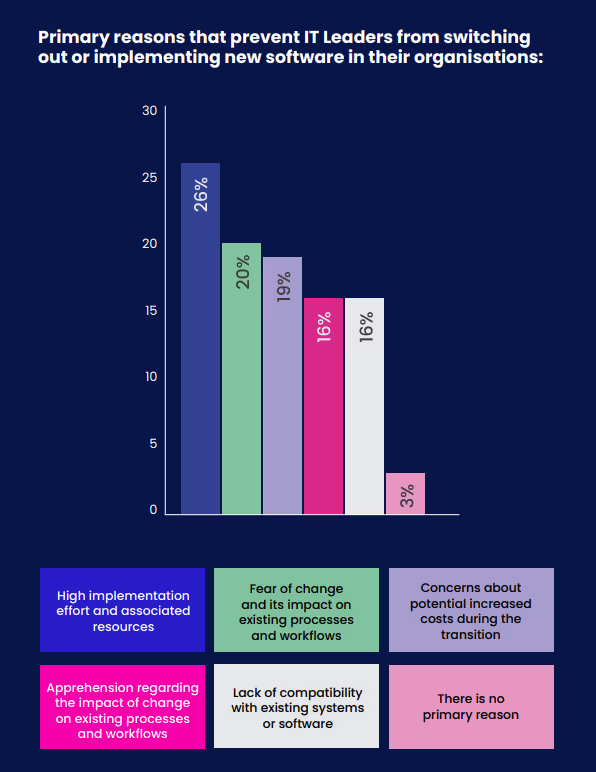
AI can accelerate digital transformation
IT leaders can use the excitement over the recent emergence of generative AI to push the case for digital transformation in their organisations. AI has the potential to be a business game-changer. It makes data useful in ways that have only previously been touched upon. Our research found that IT leaders are already seeing an impact from the deployment of AI-driven tools.
The largest number (32%) are seeing AI drive innovation and digital transformation. That should come as no surprise. AI’s ability to source and analyse mountains of data makes it easier to automate scores of previously manual tasks, creating speed and agility.
A quarter of respondents (25%) are seeing AI’s impact in better customer service and support. Again, that makes perfect sense. To take just one example, AI-driven chatbots can do more of the mundane work of customer service and support, giving human employees the time to focus on more complex or sensitive cases.
AI is also helping IT leaders streamline processes and improve operational efficiency, and only 6% of our respondents said AI had not affected their role at all. Having said that, many IT leaders face challenges around integrating AI into current technology stacks, and are looking to vendors to do the heavy lifting in this respect and incorporate AI tools into the solutions organisations already use.
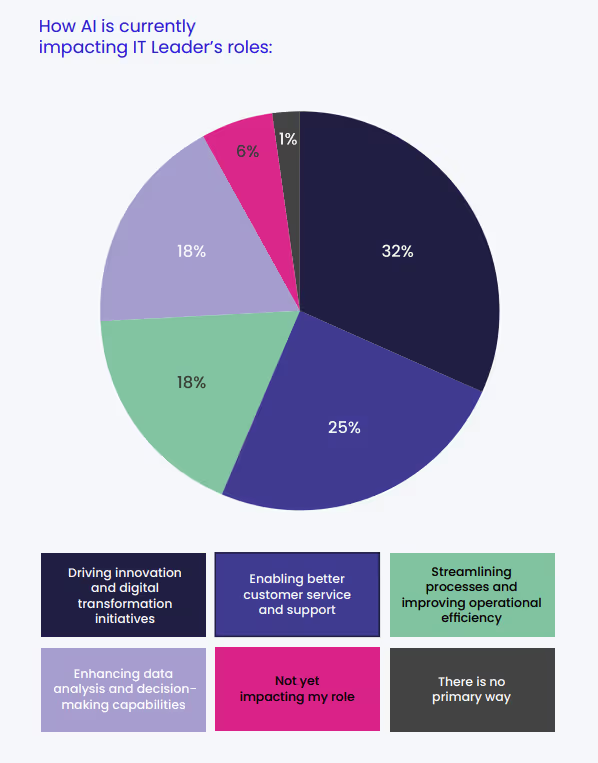
Challenge and opportunity for IT leaders
All of this adds up to a combination of tricky challenges and enticing opportunities for IT leaders. In our survey, over a quarter (26%) said their biggest challenge was managing a hybrid or remote workforce, which says something about the fundamental change in working models since the pandemic.
The same number – 26% – said controlling and optimising costs was their main concern. The instinct to squeeze more from less is entirely understandable in uncertain economic times. Other challenges were the hardy perennials of an IT leader’s lot: security and data protection (18%) and stakeholder management (17%).
But these priorities also offer opportunities for improvement. Business leaders may be amenable to new technology investment if IT leaders can persuade them that the outcome will be improved efficiency and longer term cost savings.
That appears to be the focus. When we asked respondents what their priorities were in the short and medium term, the number one choice was implementing technology that would improve efficiency. It was followed by improving data security, optimising the IT budget and improving the customer experience.
It’s notable that IT leaders are being proactive, despite economic constraints. They understand that the key to future resilience is an improved technology stack, one that can create streamlined organisations while also improving customer experience. With the AI revolution just beginning, many know that this is not the time to rely on legacy tools and applications. There may be bumps in the road, but the journey to digital transformation is one every organisation can benefit from.
For more insights on digital transformation, operational efficiency and customer experience – and what IT leaders intend to do about them – download our report.
Get the MaxContact Newsletter
Get free insights, research and expert interviews shared to your inbox every month.
Resources

AI in Call Centres: How Will AI Impact Customer Service?
You might also like

How CCaaS Can Transform Your Contact Centre Experience

Improving Wellbeing & Engagement in Your Contact Centre
In the era of The Great Resignation, staff wellbeing and engagement is certainly a hot topic right now.
Many employees are leaving due to feeling burnt out, unsupported, or undervalued in their roles. In fact, our research shows that 72% of workers said they were burnt out, and 52% said there had been an increase in workload since the beginning of the pandemic.
In the contact centre world, 64% of people reported that they were losing between three to four hours of work each month due to poor work-related mental wellbeing.
And this could have a huge effect on the wider business!
To talk about how leaders can improve wellbeing and company culture, we invited Natalie Calvert, CX+EX Coach & Expert, and Sean McIver, Product Owner at MaxContact, to a recent webinar.
You can watch the webinar in full below or keep reading for the key takeaways.
Why leaders should prioritise employee wellness
On a human level, prioritising wellness and checking in with employees is always a sign of good leadership. But the benefits go beyond that.
Research shows that good company culture increases customer experience by upwards of 75%. So it’s no wonder that 70% of executives say it’s their number one priority.
There’s a clear key link between company culture and employee wellbeing, customer satisfaction, and business performance.
But improving culture and wellbeing is not a quick and easy fix.
The customer contact industry has always had a high staff turnover, but this has increased significantly during the pandemic and The Great Resignation.
Studies show that employees are feeling burnt out and stressed which is causing them to leave en-mass.
Increased employee turnover can hurt businesses in many ways, including the bottom line. On average, it costs between £3,000 to £5,000 to recruit new staff and around 20,000 hours of training to get them up to speed.
It’s no surprise that leaders want to avoid a revolving door of staff, so they can spend that time and money on growing the business. But for this to happen, the company needs to prioritise employee wellbeing and culture.
How to reduce stress for contact centre workers
Any job surrounding customer care, queries, or complaints can come with some stress attached.
Angry customers are feeling the strain of a cost-of-living crisis, life post-pandemic, and the challenges of an increasingly remote world thrown into the mix.
But what can leaders do to protect their contact centre workers? As Natalie explained, we’re creating some of our own stress in a way.
A few years back, workers needed an entirely different skill set than they need today. The world has changed so much, so fast, and contact centre workers have to deal with increasingly complex issues, more demanding customers, and a whole range of other issues that many workplaces aren’t prepared for.
She believes that we really need to reskill our people, leaders especially, to match the needs and expectations of the modern world. If we don’t ensure our frontline staff have the right skills, we can expect high burnout and low staff retention rates.
Another thing that Sean suggested was having a system where customer complaints are recognised and analysed for trends. If frontline staff know there’s a common issue that’s being addressed at a higher level, this provides a bit more backup and support for team members dealing with angry customers.
Ultimately, leaders need to really understand the value of their people and do whatever they can to manage, coach, and support them through stressful times.
Balancing business growth with staff needs
Of course, all businesses want to grow, and growth can sometimes be uncomfortable.
But rather than focusing entirely on hitting quotas, business objectives, and handling increased pressure from customers, leaders should try to address company culture across the board.
This is not just something that affects frontline staff either. There needs to be a culture across all areas and roles, such as QA managers, finance, suppliers, and leadership.
Every subsection of the business should feel valued and supported. And sometimes, all it takes is a quick check-in with staff and some open and honest conversations.
As a business prepares to grow, so with it must the plan to support staff. Increasing or decreasing team sizes, revamping company structure, and training must all be done with employee wellbeing in mind.
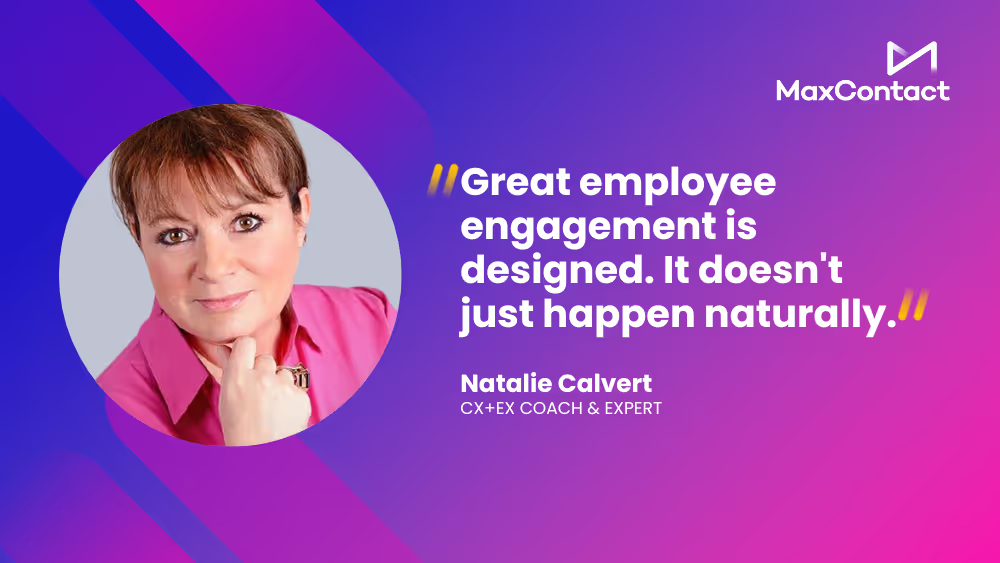
How to manage staff wellbeing in a remote setting
Natalie has two tips for this:
- > Keep cameras on
- > Run team huddles
Keeping cameras on during meetings is critical because you can actually check in with people and see how they’re doing. If your team has cameras off, there’s little engagement, and it’s harder to pick up on things that could affect staff wellbeing.
Natalie is also a fan of team huddles, which are short and sweet meetings where everyone can gather for a chat. While they take time to run, Natalie says they are well worth the investment because of the impact on employee engagement and wellbeing.
Why businesses should care about employee engagement
One of the top reasons is that it affects recruitment and retention. Engaged employees are simply less likely to quit.
When you have a group of engaged employees, you’re ensuring that they feel valued and listened to. You are also demonstrating that you are prepared to adapt and adjust as necessary.
On a wider scale, having engaged staff means better performance when it comes to business aims and objectives. Highly engaged employees are much more likely to deliver great customer experience, which impacts customer satisfaction and, ultimately, revenue. So, it’s a win-win.
But Natalie has a word of advice. Good employee engagement won’t happen spontaneously. You have to design it and to do that, you need great leaders who are committed.
Maximising employee engagement in a remote world
Just like with wellbeing, managing engagement can be extra tough when everyone’s working remotely.
But Natalie suggests focusing on a few key areas that impact employee engagement:
- Customers – Be customer-focused in all areas of the business – not just in customer interactions, but also in internal communications in the team.
- Purpose – The purpose of the contact centre has to align with the purpose of the overall organisation.
- Culture and community – Build a great culture focused on your community.
- Improvement – Make constant improvement a primary goal across each area of the business.
- Structured development – Focus on staff development and skills.
- Rewards and recognition – Celebrate successes and reward staff so they know they’re valued.

Five ways to improve employee engagement and wellbeing
Ready to rethink employee engagement and wellbeing but don’t know where to start? Natalie and Sean have you covered. Here are their top five methods for improving wellbeing and engagement:
- Have a strategy and a plan
If you don’t have a plan to improve things, you can’t expect them to improve by themselves. Go in with a plan of action.
- Talk openly and honestly
Sean’s tip is to be proactive, not passive, when it comes to open communication. It’s hard to know if there are any issues with staff wellbeing if no one’s talking about them. Encourage leaders to be proactive about communicating with their teams.
- Make sure leaders have the right skills
It all starts with leadership, as Natalie says. They need the right skills to coach and support the rest of the business. When good leadership is in place, this trickles down to employees and customers as well.
- Culture
Customer service and customer experience teams shouldn’t work in silos. Everyone needs to be on the same page when it comes to company culture, feeling valued, and knowing the core purpose of their roles.
- Employee engagement goes hand in hand with customer experience
These are not two separate things. They are intrinsically linked. If employees feel valued and engaged, this will result in better customer service and happier customers. So, if you want to improve the customer experience, one step is to tackle any employee wellness issues you have in your team. For more insights and actionable advice on how to revamp the employee experience, catch the full webinar here.


Industry research unveils how IT Leaders can support customer experience functions more effectively
MaxContact, a leading UK-based customer engagement software provider, has shared findings from their new report – ‘Operational Efficiency and Customer Experience: Insights for your IT Strategy.’ This study, based on a survey of 100 UK-based IT leaders, serves as an invaluable resource, offering data-backed insights on processes, technology, customer experience, operational efficiency and digital transformation.
Headline messages include:
- Operational efficiencies & customer experience: In a flatlining economy, IT leaders are focused on improving efficiency and performance across their organisations, with survey respondents citing ‘implementing new technologies and tools to improve efficiencies’ as their number one focus for the next six months. This proactive approach reflects the adaptability of IT leaders, who recognise that investing in advanced technologies can lead to more streamlined operations and ultimately improved business performance. IT Leaders are primarily looking to invest in business operations software (49%) and customer support technologies (43%) in the next 12 months, according to the survey results.
- AI’s growing influence: 75% of IT leaders expressed optimism about the impact of AI technologies, particularly in driving innovation and enabling better customer service. They see AI not just as a technological advancement but as a pivotal driver of innovation, enabling the delivery of better and more responsive customer service. Their enthusiasm for AI underscores its growing importance as an integral component of IT strategies.
- Digital transformation progress: Nearly half of respondents say they’ve largely transitioned to digital ways of working, though a significant minority (16%) are some way from that goal. The report reveals a mixed landscape when it comes to digital transformation. While nearly half of the respondents indicate substantial progress in transitioning to digital ways of working, a noteworthy minority are still in the process of embracing these transformative changes. This disparity highlights the diversity of digital maturity levels among organisations. A forward-looking mindset is essential for organisations striving to remain competitive in today’s digital landscape, with 99% of those polled planning to invest in some form of digital transformation over the next 12 months.
- Hybrid workforce challenges: Over a quarter of those surveyed say managing a hybrid or remote workforce split is the main challenge in their role. This challenge signifies the need to balance the demands of remote and in-office work, ensuring that employees remain productive, engaged, and connected. The report provides valuable insights for IT leaders seeking to navigate the complexities of the hybrid workforce, offering strategies to overcome these challenges.
MaxContact’s VP of Engineering, Matt Yates, commented on the report saying,
“This report underscores the resilience and adaptability of IT leaders in these trying times. It provides invaluable insights into the strategies and challenges faced by peers, offering advice for making well-informed decisions around operational efficiencies and customer experience for IT leaders. As technology continues to evolve, MaxContact remains committed to providing powerful customer engagement solutions that empower organisations to thrive in the customer experience landscape.”

MaxContact’s report is an essential guide for IT leaders, providing insights from peers that can shape effective strategies. To access the full report and explore the research, please access the report for free, here.

How to reduce average handle time in your call centre
Average handling time (AHT) is a key measure of the efficiency of your call centre. Very simply, the faster calls are dealt with, the more you can get through and – theoretically – the happier your customers will be.
We say theoretically, because there’s a caveat here. Reducing AHT mustn’t happen at the expense of service. Rushing calls simply to improve AHT is a recipe for dissatisfaction and, ultimately, unhappy customers.
But it doesn’t have to be one or the other.
In the rest of this blog we’ll define what average handle time is and how it’s calculated. We’ll also share strategies for reducing average handling time while maintaining or even improving customer satisfaction (CSAT).
What is Average Handle Time (AHT)?
Average Handle Time (AHT) measures the average duration of a single customer interaction. It accounts for total talk time, hold time and after-call work (ACW) divided by the number of calls handled.
Talk time: The total time that agents spend talking to customers.
Hold time: Time customers spend waiting for an agent to deal with their issue(s).
After-call time: The time spent on tasks, such as making notes, sending emails, or categorising the conversation. These are tasks that a call centre agent has to do before handling another call.
Average Handle Time formula:
AHT = (Total Talk Time + Total Hold Time + Total After-Call Work Time) ÷ Number of Calls Handled
What’s considered a good AHT depends to some extent on the industry you’re in. Call Centre Helper’s Erlang calculator lets you enter specific metrics to work out your own AHT, but according to its own example, an AHT of 6m 10s is reasonable.
According to our recent Benchmark Report, 44% of our respondents reported times between 6 and 9 minutes.
Why is reducing AHT important?
As a general rule, the lower your AHT, the better. It means you can handle more calls, improve efficiency and reduce costs.
AHT also gives you the information to improve resource management, and to help agents improve performance. Taken together, it is one of the key metrics of any call centre operation.
Lowering your Average Handle Time can lead to:
- Increased efficiency, so you can handle more calls with the same number of agents.
- Cost reduction, so you save on operational costs by optimising agent time.
Improved customer satisfaction due to faster resolutions but only if quality is maintained.
Why is reducing AHT difficult?
There are a few common challenges that stop call centres from achieving lower Average Handling Times.
Complex customer issues
Naturally, some customer enquiries take more time to resolve than others, increasing handling time. These complex issues might include technical difficulties, multiple queries or sensitive situations. In these scenarios, focus on delivering a thorough and effective service over minimising call time.
Outdated systems and procedures
Trying to reduce AHT in a call centre that has inefficient processes and outdated systems is never going to go well. Outdated systems that respond slowly or crash frequently mean agents wait for screens to load or systems to reboot. Lack of integration between platforms can also mean switching between platforms to gather information, which takes extra time during calls.
Complicated workflows and manual tasks that could be automated result in more time to complete simple tasks, contributing to higher Average Handle Time (AHT).
Overcoming agent knowledge gaps
When call agents lack product knowledge, communication skills and familiarity with internal processes, it inevitably leads to longer call durations as agents spend more time finding information, hesitate during conversations, or place customers on hold to seek support.
Inexperienced agents might mishandle calls and give incorrect information, or fail to resolve issues on the first attempt. This leads to repeat contacts that further inflate AHT.
Balancing AHT with customer satisfaction
You should never measure AHT in silo. A focus on call times at the expense of other indicators can certainly lead to a low AHT – but also crash customer satisfaction ratings. Agents should never be incentivised to end calls prematurely or rush through conversations.
Agents who feel pressured to end calls quickly are more likely to make mistakes or give bad advice. When that happens another key call centre metric – first call resolution (FCR) rates – also suffers.
And if your AHT starts to rise, it doesn’t necessarily mean your call centre is less efficient. It could be that your agents are handling more complex calls that require longer to resolve. It’s important to check what is leading to longer call times before deciding what to do about them.
But, AHT is important and if you do need to bring it down, there are ways of doing so that won’t undermine the experience of your customers.
9 top tips to reduce Average Handling Time in your call centre
- Use advanced call routing – match customers to the right agent
Thanks to intelligent skills-based call routing, it’s possible to connect customers with the most suitable agents based on their expertise. Matching customers to agents who are more likely to be able to solve their problems, reduces the time spent on transfers and results in efficient calls (and satisfied customers).
- Automate processes with the right technology
Choose your call centre software wisely. Good technology allows you to serve customers more efficiently and more effectively. Embracing AI technology can remove bottlenecks in the customer journey and provide an easier path to improved AHT rates.
Here are some examples of how technology can be used effectively:
- Interactive Voice Response (IVR) systems: Let customers self-serve for common queries and reduce the need for agent intervention.
- AI-powered chatbots: Handle routine questions and free up experienced agents for more complex calls.
- Improve quality by reviewing call recordings
With the use of speech analytics, call recordings can be used to pinpoint conversational culdesacs. As part of your quality assurance process, regularly review recorded calls with your agents to identify possible improvements. Skilled agents can confidently handle calls more quickly and effectively.
- Focus on agent training
Tailor comprehensive training programs that focus on product knowledge, communication skills and problem-solving techniques. Well-trained agents can handle enquiries more efficiently.
- Optimise your call scripts
Many customer interactions are similar in nature. By producing and refining call centre scripts that are easily accessible, you give your agents the smoothest route through any customer conversation. That means calls end sooner, but without agents cutting any corners.
- Use Workflow Management Systems
Workforce management (WFM) systems help ensure you have the right resources in the right place at the right time. By optimising staffing levels for every client or shift, you reduce wait times and improve the overall performance of your call centre. At the same time, you’re not paying for staff hours you don’t need.
- Monitor and analyse performance metrics
Use automated reporting tools to see company, campaign, team or individual performance analytics in one place. Regularly review call data to identify patterns and bottlenecks to make decisions.
- Encourage agent feedback
Your agents are on the front lines and can provide valuable insights into inefficiencies. To get the best from your team, create an environment where they can share feedback openly.
- Set realistic and balanced KPIs
While AHT is important, it shouldn’t be the only focus. Balance it with other key performance indicators (KPIs) like First Call Resolution (FCR) and Customer Satisfaction Score (CSAT).
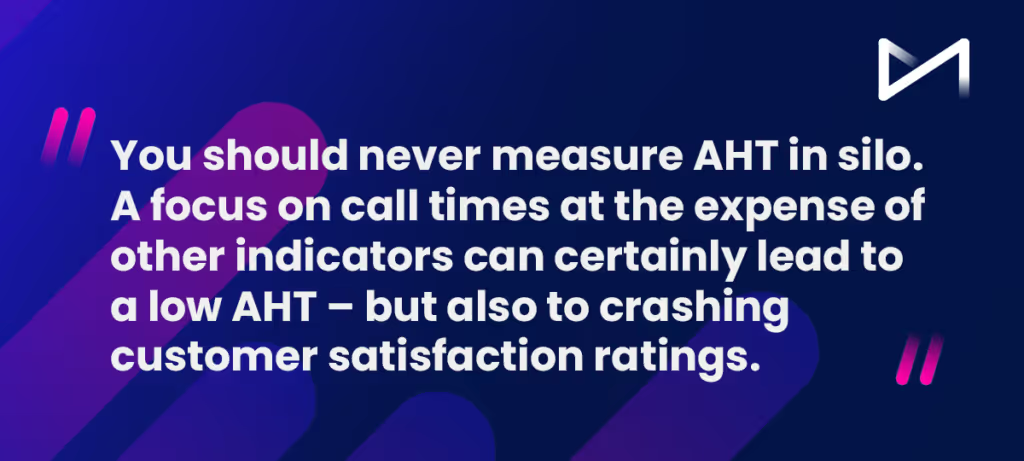
How MaxContact can help
MaxContact’s industry-leading call centre software can help you reduce AHT and improve customer experience. Our solution gives you AI-driven workforce management, powerful IVR and self-serve functions, and real-time interaction monitoring to drive efficiency improvements.
In addition, our reporting and analytics tools help you identify bottlenecks in customer journeys, so you can put the processes in place to smooth the path to resolution and reduce AHT.
For more information on our contact centre solution, click here.

How to improve staff retention in your contact centre
Like many areas of our economy, contact centres are suffering from something of a recruitment crisis.
A recent report from The Open University and Institute of Directors found that 63% of decision makers agree their organisation has found recruiting difficult.
In addition, one study of 20,000 global employers found that nearly 70% of companies were experiencing difficulties in hiring staff, a 15-year high.
Against this background, contact centres need to optimise their recruitment strategies. They also need to be doing everything they can to keep the staff they have.
More and more organisations are realising that a successful retention strategy starts at the point of recruitment. The effectiveness of your onboarding process goes a long way to determining whether staff leave in weeks or stay for years.
Onboarding matters
Onboarding really does matter when it comes to reducing staff churn.
According to studies, effective onboarding programmes can significantly increase the number of recruits who are still with a business several years later, in one case by 82%.
Onboarding is a recruit’s first in-depth introduction to your business. One study found that almost a quarter of staff who resign do so within 45 days of their start date, so first impressions really do count.
Failing to welcome staff effectively and prepare them for their first weeks on the job is hugely costly, even at the best of times.
Pre-pandemic, the average UK employer was spending £3000 – and considerable time and energy – on every new hire. That figure is probably significantly higher today.
Making contact centre onboarding better
Given that onboarding plays such a large part in effective retention strategies, how do you make yours better? Here are eight simple ways to improve your contact centre onboarding experience:
Have a plan
An employee’s first few days should be filled with interesting or fun activities. Make sure you have an onboarding plan that makes full use of their time. Leaving new starters twiddling their thumbs or unsure of what they should be doing next is not a good first impression. It smacks of a lack of organisation.
Give them basic information first
Before you get to the specifics of their role, welcome them to the business with a tour (physical or virtual). Show them where bathrooms are, where to get a cup of coffee, and where to turn for help when they’re locked out of the company intranet. Let them know of any perks the company offers, like free Friday drinks or a discount at the local gym, and how to claim them.
Introduce them to useful contacts
Depending on the size of your organisation you might not be able to introduce new starters to everyone, but you should introduce them to people who will be important to their ability to work and thrive in the first few weeks of their employment. A HR contact would be useful. If appropriate, designate an experienced employee in a similar role as a mentor or ‘work buddy’.
Give them the equipment they need
Stock a new starter’s work space with the things they might need, like pens and a notepad. Don’t make them spend time squirrelling out essentials. Small gifts – like a coffee mug or chocolate – are a nice touch.
Get the team involved
One of the most important parts of onboarding is giving new starters the opportunity to get to know the people they’ll be working with. Do this with an informal introduction session and icebreaker games. If everyone is in the office, think about organising a team lunch.
Plan adequate training time
The core of any onboarding programme is preparing new recruits for the role they are taking on. This preparation must be thorough, with plenty of time for questions and feedback. It’s particularly important for new contact centre staff to feel confident about handling live interactions with customers. Mock calls and role plays covering a number of common scenarios are a good idea. But however you choose to prepare new starters for their first days and weeks on the job, make sure the programme is comprehensive and interactive.
Talk about company culture
Onboarding is a great time to start promoting company culture. Don’t forget to talk about the company’s values and vision. If you’re doing anything notable in the ESG (Environmental, Social & Governance) space, make sure you mention it. If you support a charity, tell new starters about the form that charitable support takes and how they can get involved.
Give them the IT they need
The best contact centre software is easy and intuitive to use. Even so, thorough training is a must, and this should continue well beyond the initial onboarding period. Start with basic functions and progress through more advanced features. As new features are introduced, have sessions dedicated to them. MaxContact is your friend here. We offer a comprehensive contact centre solution that is easy to get to grips with. We also offer full training for you and your teams, for free, forever.
Don’t leave onboarding to chance
The key to all this is to put some thought into your onboarding programme, and have a well considered plan.
Onboarding is an important part of your retention strategy. It’s a time for both comprehensive training and a warm welcome. It’s an opportunity to inspire new starters with your values and enthuse them with your vision.
MaxContact can help with your onboarding strategy, by offering a fully equipped software solution and the training to help new recruits make the most of it. For more information on our smarter contact centre software, please get in touch.